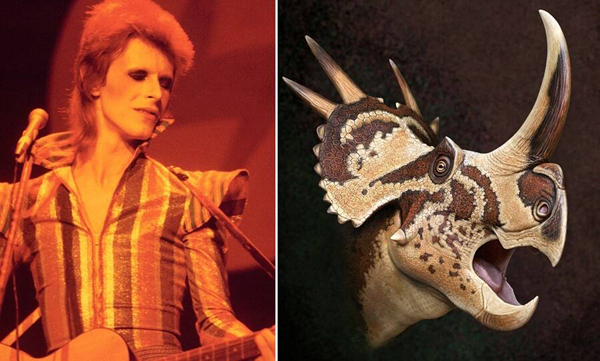A New Dinosaur Called Stellasaurus – “Star Lizard”
Stellasaurus ancellae – Missing Link from the Two Medicine Formation of Montana
A new species of horned dinosaur has been described based on fossil material from the famous Two Medicine Formation of north-western Montana. The new species named Stellasaurus ancellae is a possible missing link in the evolutionary transition of Centrosaurinae dinosaurs from Styracosaurus to one of the last of the horned dinosaurs known to science – Pachyrhinosaurus.
Stellasaurus means “star lizard”, reflecting the ornate star-shaped head crest and in honour of British rock/pop star David Bowie, famous for his flamboyant appearance and his hit single “Starman” which was released on April 28th 1972, almost 48 years to the day that the Stellasaurus scientific paper was published in Royal Society Open Science.
United by a Flamboyant Appearance David Jones AKA David Bowie and “Star Lizard” AKA Stellasaurus
Picture credit: Getty Images and Andrey Atuchin
Stellasaurus ancellae
Just like the career of David Bowie, Stellasaurus has had to wait a while before becoming famous. The fossil material now assigned to Stellasaurus was discovered in 1986, near the town of Cut Bank in Montana, close to the USA/Canadian border. The discovery was made by Carrie Ancell. It remained catalogued but not studied in the Museum of the Rockies (Montana), vertebrate fossil collection.
The contribution of Carrie Ancell, now a senior preparator at the Museum of the Rockies, has been recognised as the species name honours her. Carrie Ancell has played a significant role in developing our understanding of northern Laramidian centrosaurines. She discovered and prepared MOR 492, the holotype specimen of Stellasaurus ancellae, as well as the holotype of Achelousaurus horneri, and co-discovered the holotype of Einiosaurus procurvicornis.
Views of the Holotype Fossil Material of Stellasaurus ancellae
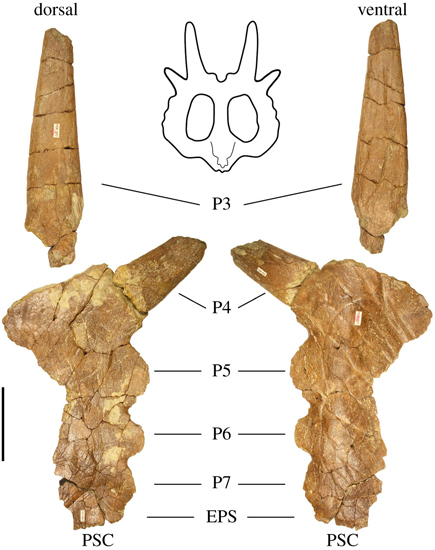
Picture credit: Wilson et al/Royal Society Open Science
Reviewing the Centrosaurinae Fossil Material from the Two Medicine Formation
A review of cranial material, specifically the ornamentation associated with the neck frill (parietal processes), previously assigned to the centrosaurine Rubeosaurus ovatus resulted in the identification of this new taxon. However, this assessment could mark the demise of R. ovatus as the researchers, which include John Wilson of Montana State University, conclude that only what was the holotype fossil, a partial parietal specimen number USNM 11869, can be attributed Rubeosaurus. This could spell the end for Rubeosaurus. When USNM 11869 was first described it was assigned to a new species of Styracosaurus (S. ovatus).
Thus, this new paper proposes that the genus Rubeosaurus is now no longer valid and that Styracosaurus ovatus is the sister taxon to Styracosaurus albertensis and Stellasaurus marks a missing link in centrosaurine evolution between Styracosaurus and Einiosaurus procurvicornis.
A Stratigraphical and Temporal Assessment of Late Cretaceous Centrosaurines Based on Two Medicine Formation Fossil Material *
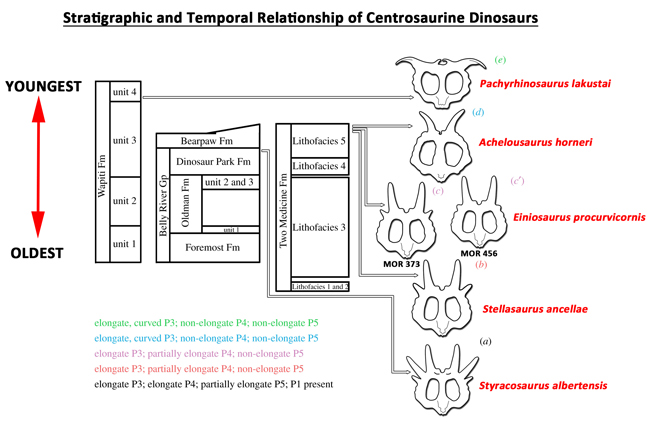
Picture credit: Wilson et al/Royal Society Open Science
A Missing Link Amongst the Centrosaurinae
The researchers postulate that Stellasaurus represents a missing link in the centrosaurine family tree. The fossils of Stellasaurus are believed to be around 75 million years old. From a stratigraphical perspective, they are younger than Styracosaurus albertensis fossils, but older than fossils assigned to Einiosaurus. That flamboyant head shield with its various lumps and bumps could reflect a transitional stage between the headshield morphology of Styracosaurus and that of Einiosaurus. It is suggested that Stellasaurus was preceded by Styracosaurus and that Styracosaurus evolved into Stellasaurus. In addition, Einiosaurus evolved from Stellasaurus.
A Transitional Process – One Horned Dinosaur Leading Directly to Another Species of Horned Dinosaur
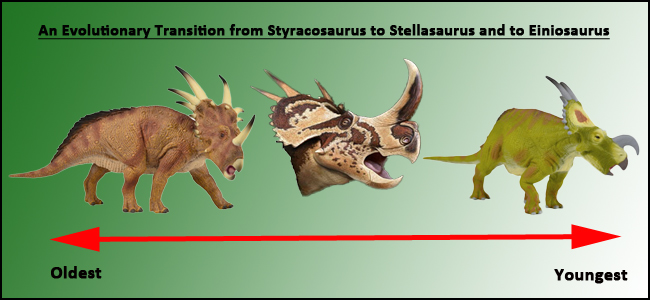
Picture credit: Everything Dinosaur/Andrey Atuchin
Anagenesis in the Centrosaurinae
Commenting upon the importance of this new research, lead author John Wilson stated:
“The ornamental horns and spiky frills on the skulls of these animals are what changed the most through evolution. The new species has skull ornamentation which is intermediate. This gives us evidence these species are members of a single, evolving lineage – this type of evolution is called anagenesis.”
The Phylogeny of the Centrosaurinae from Statistical Analysis Undertaken by the Research Team
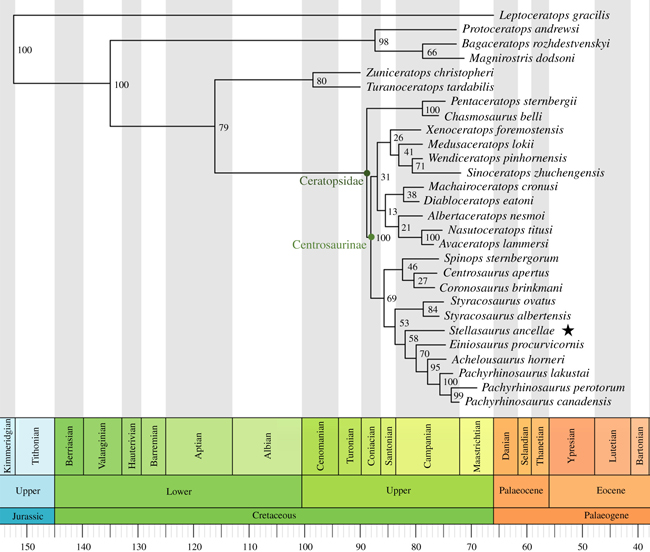
Picture credit: Wilson et al/Royal Society Open Science
The scientific paper: “A new, transitional centrosaurine ceratopsid from the Upper Cretaceous Two Medicine Formation of Montana and the evolution of the ‘Styracosaurus-line’ dinosaurs” by John P. Wilson, Michael J. Ryan and David C. Evans published in Royal Society Open Science.
The Everything Dinosaur website: Everything Dinosaur.


